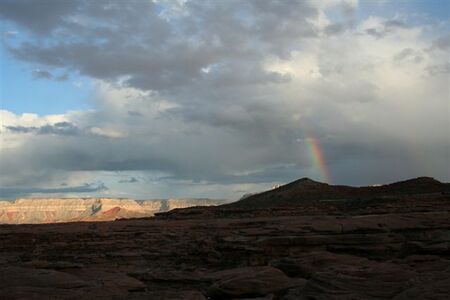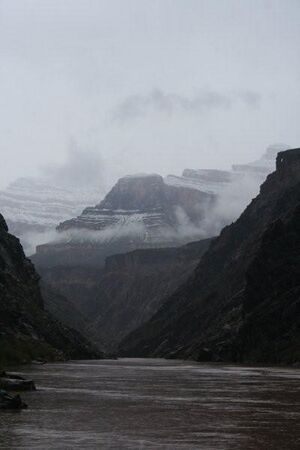Weather: Difference between revisions
(Created page with "450px|right Summers are very hot in the Grand Canyon. Winters do not get as cold as one might expect but the low angle of the sun in a deep canyon means a lot of shade. There is also a micro climate induced by the cold water which cools the air. The canyon walls create an inversion for the cooler, heavier air near the river. The inversion is around 10 feet in height. This can lead to competition in the summer for campsites that are n...") |
(starting to add GRCA weather alert info) |
||
| Line 1: | Line 1: | ||
[[Image:Esplanade_rainbow.JPG|450px|right]] | [[Image:Esplanade_rainbow.JPG|450px|right]] | ||
<span style="color:red;"><u>'''Scroll down for information on the Grand Canyon Emergency Weather Alert System'''</u></span> | |||
Summers are very hot in the Grand Canyon. Winters do not get as cold as one might expect but the low angle of the sun in a deep canyon means a lot of shade. There is also a micro climate induced by the cold water which cools the air. The canyon walls create an inversion for the cooler, heavier air near the river. The inversion is around 10 feet in height. This can lead to competition in the summer for campsites that are near the river and in the inversion. | Summers are very hot in the Grand Canyon. Winters do not get as cold as one might expect but the low angle of the sun in a deep canyon means a lot of shade. There is also a micro climate induced by the cold water which cools the air. The canyon walls create an inversion for the cooler, heavier air near the river. The inversion is around 10 feet in height. This can lead to competition in the summer for campsites that are near the river and in the inversion. | ||
| Line 30: | Line 18: | ||
|} | |} | ||
[[Image:Snow below the Redwall...Brrr.jpg|right|300px]] | [[Image:Snow below the Redwall...Brrr.jpg|right|300px]] | ||
December through January can find snow falling at the river, and sticking below the Redwall as in this January photo. April through June are the dry months. The monsoon season starts in July, peaks in August and may extend into September. While it may seem strange to talk about monsoons in the desert, this is the northern extent of the summer monsoons of Mexico. Not only can there be rain in the monsoon season but it often is very intense and flash floods are common. The Navajo or Dine that live just to the east of the Canyon call this heavy intense rain "male rain". If you are in the Canyon during the monsoon season remember to take this into account when choosing camps, locating tent sites and hiking side canyons. | December through January can find snow falling at the river, and sticking below the Redwall as in this January photo. April through June are the dry months. The monsoon season starts in July, peaks in August and may extend into September. While it may seem strange to talk about monsoons in the desert, this is the northern extent of the summer monsoons of Mexico. Not only can there be rain in the monsoon season but it often is very intense and flash floods are common. The Navajo or Dine that live just to the east of the Canyon call this heavy intense rain "male rain". If you are in the Canyon during the monsoon season remember to take this into account when choosing camps, locating tent sites and hiking side canyons. | ||
| Line 59: | Line 31: | ||
| 1.0 || 0.9 || 0.9 || 0.5 || 0.3 || 0.2 || 0.9 || 1.4 || 1.0 || 0.9 || 0.8 || 0.7 | | 1.0 || 0.9 || 0.9 || 0.5 || 0.3 || 0.2 || 0.9 || 1.4 || 1.0 || 0.9 || 0.8 || 0.7 | ||
|} | |} | ||
To find specific Grand Canyon weather information, Tubby notes that you can follow this [http://www.wrh.noaa.gov/fgz/ link] to the National Weather Service's Flagstaff site. Once there click on the map near Grand Canyon and it will zoom in. Click again on the zoomed map and it will give you a point forecast for the exact spot you clicked on. It's pretty amazing. | To find specific Grand Canyon weather information, Tubby notes that you can follow this [http://www.wrh.noaa.gov/fgz/ link] to the National Weather Service's Flagstaff site. Once there click on the map near Grand Canyon and it will zoom in. Click again on the zoomed map and it will give you a point forecast for the exact spot you clicked on. It's pretty amazing. | ||
| Line 67: | Line 38: | ||
<span style="color:red;"><u>'''Grand Canyon Emergency Weather Alert System'''</u></span> | |||
Click [[The Pre-Trip Planning | '''here''']] to return to '''The Pre-Trip Planning''' page. | Click [[The Pre-Trip Planning | '''here''']] to return to '''The Pre-Trip Planning''' page. | ||
Revision as of 07:21, 1 July 2024
Scroll down for information on the Grand Canyon Emergency Weather Alert System
Summers are very hot in the Grand Canyon. Winters do not get as cold as one might expect but the low angle of the sun in a deep canyon means a lot of shade. There is also a micro climate induced by the cold water which cools the air. The canyon walls create an inversion for the cooler, heavier air near the river. The inversion is around 10 feet in height. This can lead to competition in the summer for campsites that are near the river and in the inversion.
| January | February | March | April | May | June | July | August | September | October | November | December | |
|---|---|---|---|---|---|---|---|---|---|---|---|---|
| Max | 57 | 64 | 72 | 82 | 92 | 103 | 106 | 103 | 96 | 83 | 68 | 57 |
| Min | 37 | 42 | 47 | 54 | 63 | 72 | 77 | 74 | 68 | 58 | 46 | 38 |
December through January can find snow falling at the river, and sticking below the Redwall as in this January photo. April through June are the dry months. The monsoon season starts in July, peaks in August and may extend into September. While it may seem strange to talk about monsoons in the desert, this is the northern extent of the summer monsoons of Mexico. Not only can there be rain in the monsoon season but it often is very intense and flash floods are common. The Navajo or Dine that live just to the east of the Canyon call this heavy intense rain "male rain". If you are in the Canyon during the monsoon season remember to take this into account when choosing camps, locating tent sites and hiking side canyons.
| January | February | March | April | May | June | July | August | September | October | November | December | |
|---|---|---|---|---|---|---|---|---|---|---|---|---|
| Average | 1.0 | 0.9 | 0.9 | 0.5 | 0.3 | 0.2 | 0.9 | 1.4 | 1.0 | 0.9 | 0.8 | 0.7 |
To find specific Grand Canyon weather information, Tubby notes that you can follow this link to the National Weather Service's Flagstaff site. Once there click on the map near Grand Canyon and it will zoom in. Click again on the zoomed map and it will give you a point forecast for the exact spot you clicked on. It's pretty amazing.
Bessie notes the following NOAA weather forecast links come from the Grand Canyon National Park weather conditions webpage here.
Grand Canyon Emergency Weather Alert System
Click here to return to The Pre-Trip Planning page.

